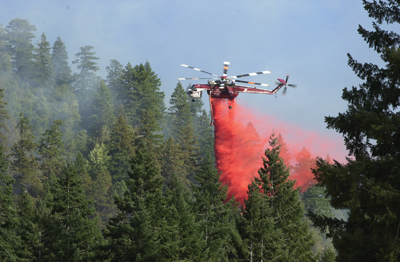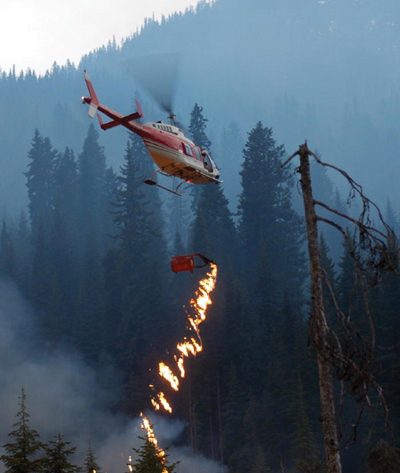
Features
Training
High-flying accomplices
Already this spring Canadians have seen images of water bombers and helicopters putting out brush fires in Nova Scotia and British Columbia. Planning for the spring/summer fire season and maintaining the necessary equipment is crucial to managing forest fires and wildland/urban interface fires.
June 1, 2009
By Blair Watson
Already this spring Canadians have seen images of water bombers and helicopters putting out brush fires in Nova Scotia and British Columbia. Planning for the spring/summer fire season and maintaining the necessary equipment is crucial to managing forest fires and wildland/urban interface fires.
 |
| The Erickson S-64 Aircrane is used in several countries, including Canada, for aerial fire suppression. It has a large hose that hangs from the underside that is used to transfer up to 9,462 litres of water, water/foam, or retardant to belly tanks during firefighting operations. In this case, the Erickson S-64 carried foam to help fight a 2002 fire in B.C.
|
In most parts of the country, fire season starts in April and ends in October. On average, about 8,500 forest fires are reported each year in Canada, burning approximately 2.5 million hectares. When provincial or territorial firefighting resources become inadequate, aircraft and crews from other jurisdictions are brought in to battle wildfires. The Canadian Interagency Forest Fire Centre (CIFFC) in Winnipeg handles co-ordination.
All provincial and most territorial governments have a forest protection agency. Saskatchewan, Manitoba, Ontario, Quebec, Newfoundland, New Brunswick, and Nova Scotia each have a fleet of firefighting aircraft, entirely fixed-wing in most cases (Nova Scotia’s is entirely rotary-wing). Alberta and the Northwest Territories have Canadair water bombers operated by companies in partnership with the government. British Columbia and the Yukon contract air tanker services. Prince Edward Island rarely needs aerial firefighting resources. In many regions, helicopter operators are hired to provide fire suppression and operations support.
In Canada’s second-largest province, the Ontario Ministry of Natural Resources-Aviation and Forest Fire Management (OMNR-AFFM) has assigned in years past, and did so again this year, four helicopters – AS350 B2s and EC130 B4s – to firefighting. Three other aircraft and their crews are deployed throughout the province for fire support as needed.
Part of the government work done before a fire season starts involves issuing a Request for proposal (RFP) for helicopter services. Operators interested in bidding must meet provincial or territorial as well as Transport Canada requirements. Forest protection agency or aviation safety officers visit operators to determine whether they meet government standards. Bids from qualified operators proceed to the evaluation stage, and then contracts are awarded.

|
|
| Some helicopters are equipped with a drip torch or Delayed Aerial Ignition Device to light backburns and controlled burns. (Photo courtesy of Alpine Helicopters) |
Helicopter Association of Canada (HAC) members have expressed concern that the flight-hours requirement in provincial tenders falls short in judging a pilot’s ability to conduct firefighting flights. Furthermore, RFP requirements have kept pilots from acquiring fire suppression experience, which could be detrimental over the next decade and beyond as highly experienced pilots retire.
A HAC pilot qualifications group has been working to establish criteria for assessing firefighting flying skills. The group’s goal is to have operators adopt the evaluation concepts as industry best practices while avoiding another certification requirement.
Government helicopter firefighting and support contracts range in duration from one to 80 days. In Ontario, for example, the average number of short-term hires – one to four days – is 190 per year. Part of the preparation work between fire seasons is to update government databases with operator information so that later in the year, when fires are raging, valuable time is not wasted trying to find companies with suitable equipment and crews.
Because aircraft must be available throughout the contract period, maintenance has to be completed before the season begins. Engine and transmission changes and avionics upgrades are done before aircraft are deployed. Firefighting equipment such as heli-buckets and hydraulic packs undergo maintenance. AMEs are sent with helicopters to forward bases so that field maintenance can be done on site. Before the start of a fire season, engineers and pilots are briefed by government staff on fire suppression operations, practices and policies.
Training also takes place between fire seasons. Ground fire crews learn to exit helicopters with their equipment and pilots practice water drops, hover exits, equipment slinging, co-ordination with other aircraft, and more. The control zone around a wildfire becomes a busy location in which there is little room for error. To operate safely in it with other helicopters, a bird-dog airplane, water or chemical retardant bombers and ground fire crews, pilots are required to perform their flying tasks proficiently and understand how their aircraft is choreographed with others in a firefighting “dance.” Operator and provincial or territorial agency training provides a solid foundation for safe operations.
To help co-ordinators track fire fighting and support aircraft and orchestrate their operations, technologies such as Automated Flight Following (AFF) have been created. AFF was developed in B.C., home to some of the world’s most challenging aerial firefighting because of the terrain. The main advantages of AFF are GPS-tracking in near-real-time and enhanced situational awareness, a crucial part of effective aviation asset management.
The history of AFF goes back 20 years when the B.C. Forest Service recognized the need for an integrated decision support system. Automatic Flight Following, which was initially FM-based, transitioned to satellite technology by the late 1990s. It is used by forest protection departments in Canada and some U.S. agencies. Where required, commercial operators must equip their aircraft with AFF technology, meeting the AFF data transfer specifications issued by the CIFFC. AFF data standards developed in B.C. have been adopted nationally and internationally.
The integrated decision support system developed in B.C. uses AFF (by displaying aircraft locations based on received data) but also incorporates fire reporting, chronological event logging, resource and personnel tracking, electronic requests for assets, GIS spatial information and imagery, fire behaviour and weather. The computer-based system, aptly named Dispatch, has proven to be a highly effective firefighting management tool.
Because communication with pilots flying firefighting or support missions is critical, forest protection agencies require contracted aircraft to be equipped with a communication system that meets their standard. Outside of B.C., low-band FM radios satisfy the requirement in several regions, but in Canada’s most westerly province as well as the northern part of the country where there are few repeater stations, aircraft satellite communication equipment is mandatory. Because of its utility, SATCOM in Canadian firefighting aircraft is common.
Technology has improved aerial firefighting greatly during the past half century. Between fire seasons, forest protection agencies and operators review new technologies to determine their suitability for fire detection and suppression. In the summer of 2007, OMNR-AFFM personnel began night vision technology (NV) testing and training. Using NVGs, crews found that it was considerably easier to detect fires, even small ones such as campfires. OMNR-AFFM evaluation of NVGs continues. Other night vision technology applications are precise mapping of active fires and extractions of firefighters in emergency situations. Two helicopters in the Ontario government’s fleet, an AStar and an EC130, have been modified with NVT. •
Print this page